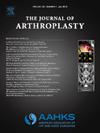翻修全膝关节置换术比初次全膝关节置换术更快实现最小临床重要差异。
IF 3.4
2区 医学
Q1 ORTHOPEDICS
引用次数: 0
摘要
导言:翻修全膝关节置换术(rTKA)的患者报告结果指标(PROMs)仍未得到充分研究,尤其是达到最小临床意义差异(MCID)的时间。本研究通过比较初治 TKA(pTKA)和复治 TKA 患者达到 MCID 的时间来填补这一空白,为了解他们的康复轨迹提供有价值的见解:多机构关节成形术登记处共对 8266 例 TKA(7618 例 pTKA 和 648 例 rTKA)进行了回顾性研究。根据当前程序术语(CPT)代码确定了完成患者报告结果测量信息系统(PROMIS)全球体能、PROMIS 身体功能简表 10a (PF-10a)和膝关节损伤与骨关节炎结果评分-身体功能简表 (KOOS-PS) 问卷的患者。利用带或不带区间校正的生存曲线来评估达到 MCID 的时间:结果:比较达到 MCID 的时间,在 PROMIS Global Physical(3.5 个月对 3.7 个月,P = 0.004)和 KOOS-PS (3.3 个月对 4.2 个月,P < 0.001)方面,rTKAs 明显快于 pTKA,但在 PROMIS PF-10a 方面相似(4.4 个月对 4.8 个月,P = 0.057)。间期校正也显示出类似的趋势,即PROMIS全球体能(0.6至0.61个月对0.97至0.97个月,P = 0.009)和KOOS-PS(0.97至0.97个月对1.47至1.47个月,P < 0.001)的rTKAs达到MCID的时间更早,但PROMIS PF-10a(2.43至2.54个月对1.90至1.91个月,P = 0.92)则不然:本研究显示,与接受 pTKA 的患者相比,接受 rTKA 的患者达到 MCID 的时间更快。这些发现让外科医生可以向术前翻修 TKA 患者保证,他们术后恢复到最小临床意义差异的时间可能比预期的要快,尤其是与初诊 TKA 患者术后最初的恢复时间相比。本文章由计算机程序翻译,如有差异,请以英文原文为准。
Revision Total Knee Arthroplasty Achieves Minimal Clinically Important Difference Faster Than Primary Total Knee Arthroplasty
Background
Revision total knee arthroplasty (rTKA) remains underexplored regarding patient-reported outcome measures (PROMs), particularly in terms of time to reach minimal clinically important difference (MCID). This study addresses this gap by comparing the time to achieve MCID between primary TKA (pTKA) and rTKA patients, providing valuable insights into their recovery trajectories.
Methods
A total of 8,266 TKAs (7,618 pTKA and 648 rTKA) were retrospectively studied in a multi-institutional arthroplasty registry. Patients who completed the patient-reported outcomes measurement information system (PROMIS) global physical, PROMIS physical function short form 10a (PF-10a), and knee injury and osteoarthritis outcome score physical function short form (KOOS-PS) questionnaires were identified by Current Procedural Terminology codes. Survival curves with and without interval censoring were utilized to evaluate the time to achieve MCID.
Results
Comparing the time to achieve MCID, rTKAs were significantly faster than pTKA for PROMIS global physical (3.5 versus 3.7 months, P = 0.004) and KOOS-PS (3.3 versus 4.2 months, P < 0.001), but similar for PROMIS PF-10a (4.4 versus 4.8 months, P = 0.057). Interval censoring also showed similar trends with earlier times to achieve MCID for rTKAs for PROMIS global physical (0.6 to 0.61 versus 0.97 to 0.97 months, P = 0.009) and KOOS-PS (0.97 to 0.97 versus 1.47 to 1.47 months, P < 0.001), but not for PROMIS PF-10a (2.43 to 2.54 versus 1.90 to 1.91 months, P = 0.92).
Conclusions
The present study revealed that the time to achieve MCID was faster in patients undergoing rTKA compared to those undergoing pTKA. These findings allow surgeons to reassure preoperative rTKA patients that their recovery to a MCID postoperatively may be quicker than expected, especially when compared to their initial recovery after primary TKA.
Level of Evidence
Level III.
求助全文
通过发布文献求助,成功后即可免费获取论文全文。
去求助
来源期刊

Journal of Arthroplasty
医学-整形外科
CiteScore
7.00
自引率
20.00%
发文量
734
审稿时长
48 days
期刊介绍:
The Journal of Arthroplasty brings together the clinical and scientific foundations for joint replacement. This peer-reviewed journal publishes original research and manuscripts of the highest quality from all areas relating to joint replacement or the treatment of its complications, including those dealing with clinical series and experience, prosthetic design, biomechanics, biomaterials, metallurgy, biologic response to arthroplasty materials in vivo and in vitro.
 求助内容:
求助内容: 应助结果提醒方式:
应助结果提醒方式:


